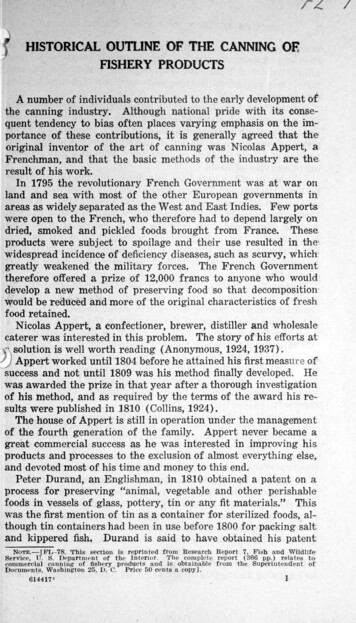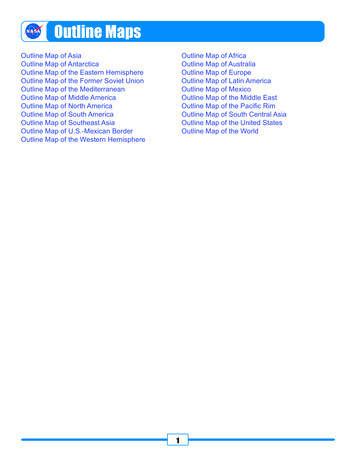
Transcription
rL.HISTORICAL OUTLINE OF THE CANNING OF.FISHERY PRODUCTSA number of individuals contributed to the early development ofthe canning industry. Although national pride with its consequent tendency to bias often places varying emphasis on the importance of these contributions, it is generally agreed that the'original inventor of the art of canning was Nicolas Appert, aFrenchman, and that the basic methods of the industry are theresult of his work.In 1795 the revolutionary French Government was at war orrland and sea with most of the other European governments inareas as widely separated as the West and East Indies. Few portswere open to the French, who therefore had to depend largely ondried, smoked and ,pickled foods brought from France. These,products were subject to spoilage and their use resulted in the',widespread incidence of deficiency diseases, such as scurvy, which'greatly weakened the military forces. The French Governmentth,e refore offered a prize of 12,000 francs to anyone who would ,develop a new method of preserving food so that decomposition'would' be reduced and more of the original characteristics of freshfood retained.) Nicolas Appert, a confectioner, brewer, distiller and wholesalecJa terer was interested in this problem. The story of his efforts at"') solution is well worth reading (Anonymous, 1924, 1937).)-:.J Appert worked until 1804 before he attained his first measure ofsuccess and not until 1809 was his method finally developed. Hewas awarded the prize in that year after a thorough investigationof his method, and as required by the terms of the award his r esult.s were published in 1810 (Collins, 1924).The house of Appert is still in operation under the managementof the fourth generation of the family. Appert never became agreat commercial success as he was interested in improving hisproducts and processes to the exclusion of almost everything else"and devoted most of his time and money to this end.Peter Durand, an Englishman, in 1810 obtained a patent on aprocess for ' pr eserving "animal, vegetable and other perishablefoods in vessels of glass, pottery, tin or any fit materials." Thiswas the first mention of tin as a container for sterilized foods, although tin containers had been in use before 1800 for packing saltand kippered fish! Durand is said to have obtained his patentNOTE,-[FL-78. This section is r eprinted from Research Report 7, Fish and WildlifeSer Vice, U. S. Departm ent ot the Inter ior . T he complet e report (366 pp.) r elates t ()commercial canning of fish ery products a nd is obtai nable f rom t he Superi ntend ent ofDocumt'nts, Wa shin gton 25, D. C. Price 50 cent s a copy ] .614417 ·1/
2RESEARCH REPORT 7, FISH AND WILDLIFE SERVICEthrough knowledge imparted by a foreigner who is believed tohave been Appert. Durand's method cal'l1:e into extensive use onlyafter 1820 when P ierre Antoine Angilbert invented a tin container less subject to leakage, and which could be made morerapidly t han formerly.Canning was first developed on an extensive commercial scalein the United States and most of our pioneer canners were primarily packers of fish and seafoods ; packing fruits, vegetables and preserves as secondary or incidental items. Strangely enough, thepacking of fishery products presents more difficulties than processing other types of foods.Canning is said to have been introduced into the United Statesby Ezra Daggett and Thomas Kens ett in 1819 when t ey packedoysters and other seafoods in New York (Cobb, 1919). WilliamUnderwood is credited with establishing a plant in Boston in 1820,packing lobster and fruit in glass. It is understood that thesemen learned the art in England befor e em igrating to this country.The Underwood plant was later r eor ganized into the firm of Wm.Underwood's Sons and is still in existence, the oldest in theUnited States.Thomas Kensett was the first to break away from home kitchenmethods and deserves credit for t h e development of the firstcanned product to receive wide distr ibution; namely, the oyster.The pioneer development of the industry in the Chesapeake Bayarea, the first important canning center, is due to his efforts.Others are said to have engaged in the industr y in the Baltimorearea before Kensett and as stat ed above it is believed that oysteIi were canned as early as 1819. The first systematic effort at the 'large scale development of a product was made by Kensett in 1844,when he began packing oysters in Baltimore. Collins (1924)reported:Oysters and seafood were t he first products t hat became popular. Inlandcities could get fresh Baltimore oyster s packed in ice through the winter ; butfolks in smaller places seldom enj oyed such a luxury-the countryman's greatest treat when he went to town was an oyster stew. Baltimore and Bostoncanned oysters so they would keep f or m onths, and could be bought at anycountry grocery store by people who had eve r eaten a fresh oyster.Increase in production was gradual over a period of about 20years beginning in 1844. The first big increase in demand camewith the Civil War. P reserved foods were needed for feeding thetroops, thus enormously increasing the demand and creating additional consumers for canned seafoods. Men who became acquainted with these products in the Ar my demanded canned foodson their r eturn home and introduced them among their neighbors.Our most important fish canning industry, namely salmon, hadits beginning during this Civil War period. Salmon is said to have
CANNING OF FISHERY PRODUCTS3been canned first in Aberdeen, Scotland, in 1824 and it is claimedthat the first salmon canned on the American continent was packedat St. Johns, N. B., in 1839 "and in Maine shortly after this time.However, it was never packed on an extensive scale as were lobsterand oysters. Neither at that time nor since then has the packingof salmon been of any importance on the Atlantic Coast. The industry had its real beginning in California, first became importanton the Columbia River and reached full development when salmoncanning spread to British Columbia, Alaska, northern Japan andSiberia in the order named.George and William Hume with their friend A. S. Haps-ood werethe creators of the Pacific salmon canning industry (Hume, 1904).The Hume brothers, who had worked as fishermen at their home inMaine, went to California as Forty-niners. They noticed that salmon were plentiful in the Sacramento River and believed thatmoney might be made canning the fish. They went back to Maineon a visit, induced A. S. Hapgood, a lobster canner, to r eturn westwith them and the first Pacific salmon pack was made at Sacramento, Calif., in 1864. The pack was a failure the next year, butconditions were reported to be extremely favorable on the Columbia River, so the Hume firm moved their equipment to Eagle Cliff,Wash., about 40 miles up the river from Astoria and made the firstpack of Columbia River salmon in 1866.Canned salmon was introduced to England and Germany wherethe first large market for this product was established by shipsloading wheat and lumber for European ports. Canneries became.) umerous along the Columbia River and as · the sale of cannedsalmon increased steadily the industry sought new and profi t ablelocations, first at New Westminster on the Fraser River in BritishColumbia in 1867; then at Mukilteo, on Puget Sound, WashingtonTerritory, in 1877; and while Alaska is today the most importantsalmon canning area, its first cannery was not built until 1878 atKlawak, on Prince of Wales Island.Salmon is said to have been canned as early as 1877 in northernJapan, but commercial operations date from 1890 in that area(Anonymous, N. D.). The salmon canning industry was established in Siberia about 1906. The largest pack of canned salmonwas made in 1936, when production amounted to a world total of13,720,423 cases of 48 one pound cans.Sardines were first packed at Nantes, France, in 1834, and by1860 a fairly good market had been created for French sardines inthis country. Efforts were made to establish an American industry in 1871, utilizing young menhaden as raw material. In U 77Julius Wolff began canning small herring at Eastport, Me., and iscredited with starting the first really successful American sardine
4RESEARCH REPORT 7, FISH AND WILDLIFE SERVICEcannery. In a f ew years a large number of sardine canners wereoperating in northern Maine and nearby Canada.Several effo r ts wer e made during tlie 1890's to establish sardinecanning on Puget Sound or in Alaska where large quantities ofherring '" ere available, but all of these operations were shortlived. The first successful Pacific Coast sardine cannery was established at San P edr o, Calif., in 1896 (Bitting, 1937). The industry developed slowly until 1917 when the pack was suddenlyincreased to a large amount by war demands. After the war, production was maintained and increased by extensive cultivation ofthe export trade. When the depression of the 1930's destr6yedthe export market, a slump in production occurred but this hasbeen largely overcome by development of the domestic market.The Pacific sardine industry is center ed almost entirely in California where it originat ed. A small pack is canned on the Columbia River and in British Columbia.Shrimp were first packed in the Gulf of Mexico area. G. W.Dunbar of New Orleans, canned shrimp as early as 1867 but haddifficulty with blackening a nd discoloration. He solved this problem in 1875 with the invention of a can lining which aided greatlyin overcoming blackening. Shr imp packing soon became and remains today the principal fisher y canning industry of the Gulfcoast. Shrimp are also canned on the Atlantic Coast in Florida,Georgia, and South Carolina, but the amount packed on the Atlantic Coast is much small er than on the Gulf Coast.While Baltimore was the center of the oyster canning industryfor a long period, oysters are packed there today only occasionally The catch of the Chesapeake Bay region has decreased greatly andthe oysters of this area a r e now more profitably marketed in thefresh state. The greater portion of the ·oyster pack is now prepared on the Gulf Coast, the industry centering around Biloxi,Miss. The most recent :levelopment in the oyster industl y is theestablishment of oyster canning on the Pacific Coast. The introduction of the Japanese or "Pacific" oyster created a surplus, unmarketable in the raw condition. After several years of experimental work, this oyster w as canned commercially in 1931. Thepack in that year was 7,930 cases, increasing to 118,853 cases in1936.Burnham and Morrill are credited wit h establishing the firstclam cannery in the United States in 1878 at Pine Point, Me.( tevenson, 1899) . The pack of canned clam produ cts was smallfor some years as considerable diffic ul ty was experienced with discoloration but production slowly incr eased when this difficulty wasovercome. P. F. Halferty developed a method for canning mincedrazor clams about 1900, building up a commercial clam canning
CANNING OF FISHERY PRODUCTS5industry in Oregon, Washington and Alaska. The inclusion ofminced clams, broth and clam chowder in the list of clam productincreased the value of canned clam products until they are nowfifth in order of importance of the canned fish ery products, therebydisplacing oysters.Crab was first canned in this country by J ames McMenamin ofNorfolk, Va., in 1878. The canning of crab meat has never becomeimportant on the Atlantic Coast and the quality of the pack hasbeen variable. The great est obstacle has been discoloration. In1936, a method to overcome discoloration was developed by Fellersand Harris and in 1938 Harr is packed the common or blue crabof the Atlantic coast commercially. The principal obstacle to agreater development is believed to be the competition offered byimported crab meat.Canned crab is in considerable demand in the United States butmost of the supply originates in Japan. Indeed, this country is themost important market for Japanese canned crab, which is a different species from the common American varieties.While the crab canning process is said to have been developed in1892, the Japanese industry was not established on a commercialscale until 1908 (Anonymous, N. D.) . Japanese canned crab began to enter the United States markets in appreciable quantitiesduring the World War years, until in 1931 imports amounted toalmost double the domestic production of fresh and canned crabmeat (u. S. Tariff Commissio , 1933).)A domestic crab canning industry has been developed during the, ast 10 years in Alaska, Oregon and Washington. Processing andother technical difficulties have been overcome and a market hasbeen developed in the Pacific Coast States. It is not believed thatthe Pacific Coast crab canning industry can be expanded suffici ently to supply the dumestic demand for canned crab.The large supply of groundfish in the North Atlantic has beenthe basis of numerous attempts to develop a canning industry, whichhave not been particularly successful because of competition withother canned fishery products or insufficient advertising. Cod andhaddock products such as fish flakes, fish cakes or balls and finnanhaddie have not found a wide market outside the New Englandarea and are packed on a limited scale. Fish cakes were firstpacked in Boston in 1878. Finnan haddie (smoked haddock) wasfirst packed about 1890, and a steady but not large demand existstoday. Fish flakes, or "salad fish," the flaked meat of cod and haddock, are believed to have been developed by Burnham and Morrillof Portland, Me., in 1898.At the turn of the century, the industry was experimentingwith a variety of products. A number of articles were sold com-
6RESEARCH REPORT 7, FISH AND WILDLIFE SERVICEmercially that are not found on the market today such as pickledsturgeon, smoked lake trout, carp, shark meat, menhaden, and avariety of specialty or delicatessen products. Some of these packsdid not make a good product, others were not in sufficient demand,while in other instances the cost of raw material became too greatfor profitable operation. About 1900, the annual pack of cannedfish er y products was less than half of the amount produced today,and it was thought that production could not be increased greatlyor even maintained. The lobster canning industry, once almostexclusively confined to the United States, passed almost entirelyover to Canada after 1896. (Cobb, 1919.) While these gloomypredictions were being made the canning industry of fishery products was on the threshold of its greatest development. Productionof the standard varieties has been greatly increased and np.w products have been developed on a considerabl e scale.Canned tuna is on e of the more recently developed canned fisheryproducts, first packed commerciall y in 1909. O. W. Lang states :According to those who are intimately connected with California fisheries,the packing of tuna had its incep t ion in the Sou thern California Fish Co. * * *This company, between its date of incorporat ion in 1892 and until 1905, wasinterested only in the production and m arketing of one-quarter and one-halfpound square cans of sa rdines in oil and the one pound oval pack of the larg ersardines. Serious foreign competition, principally from Norway, encroachedupon the business, and it wa through the reso urcefuln ess and ingenuity ofone of its officers that experiments were conduct ed during 1905, 1906, and1907 on the canning of tuna. T he tests- were conducted under the directionof Mr. Lapham, t he president , w it h Wilbur F. Wood and J ames McMann a( jthe active investigators. T heir sou r ce of r aw material was albacore, whic when cooked, they all agreed, r esembled chicken in t aste and flavor. This characteristic flavor, no doubt, added impetus t o their experiments, but it was notuntil 1907 t hat their efforts were r ewarded. * * ** * * The fi rst successful pack wa s produced in 1909 when 2,000 cases werepacked which were market ed by Sigmund Seem an, Seeman Brother, NewYork.Mackerel was canned in small quantities in New England asearly as 1843. The intr oduction of mackerel into the generalcanned food market occurred in 1927 when George Ogawa put upa pack of 10,725 cases of Calif ornia mackerel " salmon style" whichwas sold at a price to compete with the cheaper varieties of salmon.Production of Pacific mackerel increased to 388,5 00 cases in 1928,and rapidly reached a peak of 1,795,700 cases of 48 one-poundcans in 1935.The most recently developed canned fish ery product is not intended for human consumption, but is prepared for feeding petsand f ur animals and for use in fish hatcheries. In 1938, 413,434cases of pet f O'od made from fisher y products were packed. P r oduction is divided between California, where mackerel or whale
CA.NNING OF FISHERY PRODUCTS7meat is utilized as the basic ingredient, and in New England wherepet food is a byproduct in the packing of fish fillets.Are there possibilities of further expansion in the fish canningindustry? Yes, if world trade conditions improve, and the products are scientifically developed and properly marketed. Newproducts may be marketed profitably only if the canner has agrasp of the required technical data, operates on an economicalbasis, and the article is of acceptable quality and can compete successfully with established products on the market.STATISTICS ON PRODUCTION OF CANNEDFISHERY PRODUCTSThe canning of fishery products is the most important factor inthe fishery industry today; indeed, canned fish and fishery products hold an important place in the general food canning industry,exceeding canned meat and meat products both in quantity packedand value to the packer. The total market value of all fish andfishery products to primary handlers in 1938 was estimated atabout 214,000,000 (Fiedler, 1939 ). The fish canning industryaccounted for 83,446,000, or 39 percent of this total.About 160 species of fish are utilized regularly for food in theUnited States. Fifteen are canned regularly on a large commer":cial scale. while a number of others are packed occasionally or inquantities too small to merit separate record in statistical reports.The record domestic pack of canned fishery products was produced, in 1936 and amounted to 794,707,014 lbs., valued at 94,564,254.Salmon is the most important canned fishery product, its valuein 1938 amounting to 50.8 percent of the total value of all cannedfishery products. Next in importance are tuna and tunalike fishes,sardines, shrimp, clam products, mackerel, and oysters, in the order named. The seven varieties listed above account for 96 percent of the value of the total pack. While canned sardines rankedsecond in value in 1929 and oysters fifth, these products haddropped to third and seventh places, respectively, in 1938.NUMBER OF PLANTS AND DISTRIBUTIONACCORDING TO PRODUCTSA total of 382 food packing establishments was engaged in canning fishery ' products in the United States a"'1 :1 Alaska during theyear 1938. In comparison with 1929, this represents a decreaseof 23 percent; 497 canneries were r eported h1 operation that year.The data presented in table 1 show that 33 percent of the cannerieswere engaged in packing salmon, 16 percent packed clam products,15 pArcent ·sardines, and 13 percent packed shrimp.
RESEAR H REP RT 7, FI II AND WILDLIFE .'ERVICET ABLEl.-Cann d fi!lh ry 1)roduof litI IInil dtalIIaml .1/a lfkfL, l .?.Jfl.[S umm ary of IJr l uction by rc)mm",1\ti, 1ProuuctSalmonUnited Slal' --------------------In kn . . -------. -----Snruin g;Maineali rorn inNumb"roe "1,,nUl21:11:!.261.67112.751.11:1Stur :Ct;'on cQ.vi urIWhitefi h ,.o lind to"l"rSalmon roe nnd ('·H",i r (fur (nt)d)Snlm"n egll' (for I lit)]\fi,r.Jlnnellu Ii h IIn,1 ro'lam Jlrodurt.Oy.t t IQ6,!Hffill,Q -.1H):;,21IQ2'·Pllun,]47:1.7212:;:!f)Fi hro,IITun akerel'Indlunrtlike Jhh· -- -------MnAlewives lewife roe .had . -------Shad roeCnt Rnd dOK foodOak esFinnnn h"dd i., cnk 'S, ball., dr.Fi,h pn . teFi h:LUnda"lco }:! II.,- .!';37. II10, I 3,01;113.1311:;,121III)lJI3';n,21) So" 72. J Ql.n;;'!I. j'!I:I.iI1.fi- fl-hrimp . rnb. . --------- ---Turt h: prndud).lis('l'lIaneou ehdlfi. hTotal I ---I "("ul out" or "urninvrl" \\t·i"ht of elln congrll"'s J'an conh'nt for olht't- clam "roclucl . E. llu h"( (If dtll)lica ionnGEOGRAPHICAL DISTRIBUTION Of THE INDUSTRYDuring 193 fi h ry pro iuctcann d inandAla ka .la ka alone a c untper nt of heal vaLueof the pack in that 'ear, while thacificof \\ a hington, Oregon and alif rnia a c unt d for 4 percent. Ther fore, the Pacific oa t including Ala ka ontribut 1 -! percent invalu e of the total pa k of canned fi hery product in the 'ni ewere aboutual inStates. The Tew England and nlfimportance, each accounting for and percent, r pectively, ofthe total value of the pack. Mo t of the r emainder was canned inthe Middle and outh tlantic tate, with a mall amount ofspecialty products pack d in threat Lak Area.Alaska ranked first in value of canned pl'oduc becau e of itproductive almon fi herr.alifornia wa econd with 30 percent due to its sardine, tuna and macl-erel fisherie . \ a hingtonwith 5 percent, was in third place, owing it rank largely to almon, clam and oyster product. Oregon and Maine each accountedfor 4 percent, the first because of its production of almon andalbacore, the latter due to its important ardine industry,The geographical distribution of the fish canning industry inCanada parallels th.?t of the United States in that the industry iscentered on the P acific Coast. The total value of the pack in
9CANNING OF FISHERY PRODUCTSCanada in 1938 amounted to 16,297,611. In that year BritishColumbia, the only province of Canada bordering on the Pacific,was credited with 12,747,172 of the value of the production ofcanned fish and shellfish, or 78 percent of the total. Salmon accounted for 12,267,465 or 96 percent of this amount . BritishCohlmbia is' exceeded only by Alaska in the canning of salmon onthis continent.8 -------------------- -------------,ALLOTHERSMACKEREL(/)6TUNA :)Z MAINESARDINESOs0.zCALIFSARDINES .-14.-1 :)w 3CY :)z. ::: I2SALMON . 01929 1930 1931 1932 1933 1934 1935 1936 1937YEARSFIGUREI.-Production of canned fi shery products 1929-1937 . Detailed statistical data on the fish-canning industry in theUnited States are given in Tables 1, 2 and 3. Figure 1 illustratesgraphically the production of the more important species utilizedby canning, and a comparison of the quantity canned in variousyears.
.o TABLE 2.-Pa.ck of canned fis /H'?']I product! ill the United States and Alaska. 1921 to 1998I StandardIrllM '"tlo SardinesSalmonYearPacific Coast 8 .1929193019311932-19331934-1935-1936 .193719381.002.948733,2 11i1.367,263H58,6G2l.rolis,slaR:lIi,7381,»04 ,4G 11!42,n031.620.»2:11.054.0011,336,2346M,460U 36,fln I!I01.20 8»·I,7(;Sfi27.r.7 1RaG.an1 7:.!,7 1 !I,23 I ,I ;;8,G:l3, 2 112,fi60,fi6fi!I,3!1 1,4 581;.,616.:112):1,1 10.081B,lIR6.:!oa4,711.IG:!7.RGIi.!!OaH,20fi,n 176.707,1:10r.:lO!I. l :1RR,:l1\6, 1sr.5,7:!8.RH2Total'\ lnxka"JainI'oluQ.tIr. !l!1.7i Ir.,23 1.8!l86.IO:!.P60 ,:!63,Si71 1i.31\3," (;,018,550i. IIiIl,S:!Or.,07G,f17!1r.,!I!!R,R0610.16H.31\5 U. .S!t,r)31IS.OliO.OO I30,OIR.26 1 211.1167.1693!U20 .71715.53:1.67312, 10 1,60 Ii ,3G 1.6071i1;' I I.30R1'alu 1.3!1!1.(;071,1\6!I.i HIl.:!7 .::!77l.R!\9.'l!!1iI.RiO,7S11l.71 j .S37tr.,72S.ifill. 6:!.1 r.I.R3IUI3:!.055.; 'iItUlnO,r,, 2r.6,O 'i.6!17:!.O:!S.SOI29,69fi.S126,O fi,17 fI.7 11).01-). !IOIl.Hr.!!1. n ;.M'o,1:!.IlSS,96398.0QS.176:!S . 160.0M:\n,2 11.n 171: . 817,8(173:.!.l7fi.:!A6I 3',n "1":W.OH6. I;1It 7760,061.011 1.7 I r. 111\211,376.0 II:17,611.%0:!fi.iA8,13r.II ,n l, SS3Il. fi 17 ,7mlas.S3G.8!!7b,3tl:!.,l flt;R.:I"!l.O:Ir.S. lf:t,7.1ir.r,.O ir,2.P33.!I!l 17.:!7 .71!·12.366.1 3,!1S0.'l11i,760.IO!1".288.8657,l 11.0266.716,7016.7:!7.388S,:!Hl.030.076.6 16.sn.'l-l6I.I MI.Oil'1I85:i082.641.181l,ti!',5 , SH3.816. 1905. 112 .750r. 15.6!17!1'10.'1061.1 12.7301.IHr.SGO1.6RO.:!11671.6361.370.050:!.S!li.S 186.7I O. 1 5 ,-P'IS.Si!!:!.86i .015 ;--J x Zt:I §C;aUlt j &i
-TABLE 2.-Pack oj canned fishery '}.1?·oducts in the United S tates and Alaska, 1921 to 1938-ContinuedYear192 L1922-19231924 . .1925-1926192719281929 . . .19301931-19321933 .193 4- . .1935193619371938-OYSt(JTSTuna a nd tunalike fi sh esShrimpClam product8CasesVal .wCasesValueCasesValueCa-sesValue549 ,1 50672,32 18 17,83 6652 ,41 61,102 ,47185 1.1991,250,8 181,216,2221,504 3062,0 10,6401,216,9761,206 ,1771,443,1 331,966,9432.510,8282,680 ,7343. 144, 50 12,754, 143 3,074,6264,511,8736,9 14,7605,756, 5868, 499,0805,282,283·8, 368,2278,374,0 30442,08650 5,973524 ,544447,481654,7554 13,834447, 297503,952519,14 5396.174306.278392, 664348,130438,542500 ,885528, 70 5708 ,05 0482 ,441 2, 179,27 12,423,6 162,720,0732,478,0443,721,1592,0 26,5692,367,9492,760, 5762,732 ,4781,836,862963,5251,007,6241,076,3181,871,0 602,044 ,9 032.180. 8692,032. 6811.886,47 851,831909,9498 18,491821,375758,106860,4621,021.8221.086,3459 17 ,4401.286 ,40 61,077,003 3 ,804,7813,.064,0874,38 1,5344,608 ,9503,782,8194,122,0925,32 1,6525,18 1,5475,528,7924,960,5423 ,982.2472,59 4,9803,479 ,4774,403,0774,721,8724, 672 ,1987 ,1 30,7474,872,393(1)(1) 1,166,5071,716,3651,710,6162, 722,666,04 52,256,9091,797,0021,7 66,4 062,713,2282,680 ,9352,976 ,2973,013,4463,189,628- - -- -9 , 8 73 ,45 13, 055 ,8767,279,3926, 183,01 96,934,48510,009,54212,823 ,72914,715,39 118 ,995 ,77 915,1 83, 636-- --(1)(1)(1)(1)525 ,28653 1,640554,639558,884500,040371 ,288434,500633,05 5666,981754.334773 ,448769,665 ZZ.ZooI%j::lUJ:r: ;got:::IC(j -3tJ). -.
I:\:)T ABLE 2.-Pack of canned fishery products in the United States and Alaska, 1921 to 1938- Continued Ultrj Mi scella n eous fi sh ery p rod ucts(")Y ear1921- . .1922192L1924-1925-1926192719281929 .1930193L1932193319341935 ,.19361937 .1938Other fi shFish roe. caviar a nd eggsOther shellfis hCasesV alueCasesYolueCOUll1'alueCases ,(1)( J)(1)(1)(1)(1)(I )(I)( I)( 1)( I)( I)(1)(I)(1)(1)(1)(I)(I)(I)(I)( 1)(1)(1)( 1)( 1)( 1)57,58678,39,146.50 192,47850,87 139,37442,9 1246,85261.41359. 04 069,97461, 337(I)(I) 477 ,4 1568 1,150502, 0401.6 19.6241,02 1.70 1635,720635 ,549821. 528960,34U1.028.29399 6,l G!)786 ,441(1 )(I)(1 )(1)( 1) 1,765,888a,70S.U 181.68 1.87!)2.399,886I.S2!l.1951.174 ,1 0 13.148 ,9'11236 .679683.255913 ,088402 .666329,883307, 1031,074, 52·'1,722 .1 602, H 6.054J .669 .63 t1.44 0.5971.599.0 66(1)(I)(1)(1)(1)4,J7910,6!l011.9 122:!,83!116.61311 .24730. ,\!)0(I) nU73173 , 5 ,)1,8:12.7:!7:!, 566.2531.7SH. U'll1.56!l.770J ,70S .0!loGa.71 fi·1 73. 3768,78660.fi25117 ,681,15:! ,6·J8rlBS .7ml5 11, I8n. - . ---(I)298,614712.239l174.501517,!l73I . U 7 . !J liG. ll r.,O\J fi!I.lnH17 . ti!l:!(I)211,30 I282. 171170.370107.90731 l. 35 17 ,46 1.2876.,13 1,7601.9l15.8905, 180.63 ,1Grand totalTotala '7 . H7357.72 1" ollte 1,234,9901.2 16,7001,287.8532. 121.41! 2,256,8772,003,5482.334,776·l.ii 8 . 5 35, 101,2201.30l,!)S43,O:? 1,:?C61,!l7S,O:!S'l.Ol18,8 H6, 10!I,H578,872 .3 176,\1 15,70 16,577 ,S686,17 8,56,J"ollle 46. 634 ,7 066 0.4 6 4, .Jj72 ,44 5, 20 572, 164.58980,577.13886 . Ul3, 2408 1.38 1.13395 .87 1.85 101.065,05 582.858.26 162,948.7 9 143.14!) , 18259,7 99.9 6380,02 1. 34 74,999.03 1!l4, 564.25 1105. 174.93 583044 5,88!)-Not enu m el'a Lecl sePRI'ately pri or to 1927.Note: "Stan dard cases" of sa ll no n , Ca li [orni a sardines, fi sh roe, cavi n r n nd eggR. other fis h , Ilnd oUwr .)",lIfis h rl' Il!'l' l'nl th(' " ndouB sized CRses ron"el·t edto t he equ iva len L o f forty-eig h t )- ])ound ca ns; Maine SArdin es , on e h undred I ,- pou ncl can s to t he CMC: t un a a nd t unn like ftahes, fOI·ty igh t l'-l- poun cl cans t othe ca se; oysLers, i orty-eig ht 6-o unce can s to t h e case; s h rimp. fo rt y eig ht 6 ounce cnn s t o t h e cnse in Ihl' dr) pnc k " nd forty eig ht 5 81 -{)un ce cans to theca se in the w etpack ; a nd cla m Pl'oduct s f Ol'ty- eigh L No. 1 cans to t h e ca se.1t:I: '"0o -3:-J"':l.Ult:I: Zt::l .t"'t::lt"' U:Jtt:I .(") trj
CANNING OF FISHERY PRODUCTSTABLE133.-Canned fishery p1'oducts of the United States and A laska, 1 93 8[Valu e of p roduct ion by States]StateCann ed prod uctsMa in e . h c l: }-------- ----------------- ---- -----------N ew York[ ;if Ti -!- -. - -. - :Vi rginia . .N ort h Carolina .Sou t h CarolinaGeorgiaF lorida . .Ala ba ma a n d Miss issippiw uisiana . .T exas, Illin ois and Wi scon s inW ash in gtonO r egon .Ca liforn iaAlaska T ot a l3,3 19,2121,354 ,127564,2671,215,126506 ,476104.50265 ,0283 12,208743.663347,9 141,9 17,6372,776,572525.9283. 76 2 ,5753,638 ,8 1525,232 68837,059, 15183 ,4 45 ,889
in the United States and most of our pioneer canners were primar ily packers of fish and seafoods ; packing fruits, vegetables and pre serves as secondary or incidental items. Strangely enough, the packing of fishery products presents more difficulties than process ing other types of foods.











